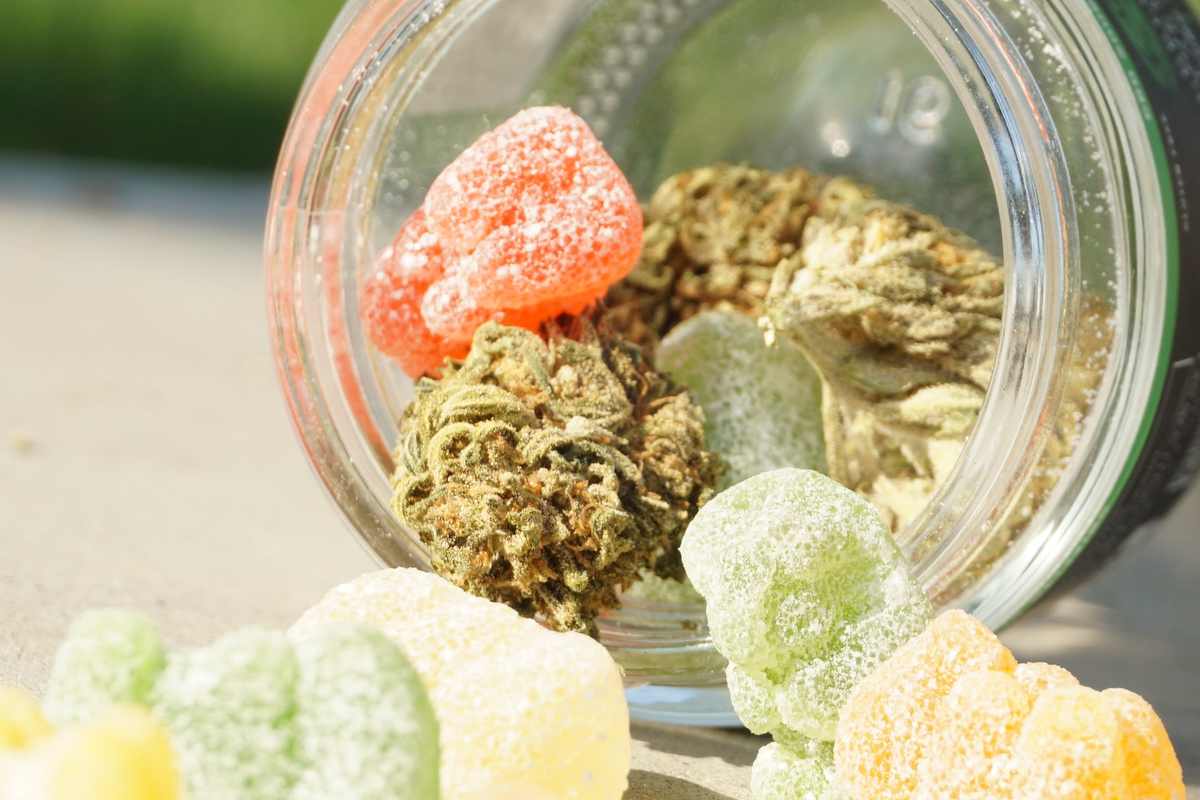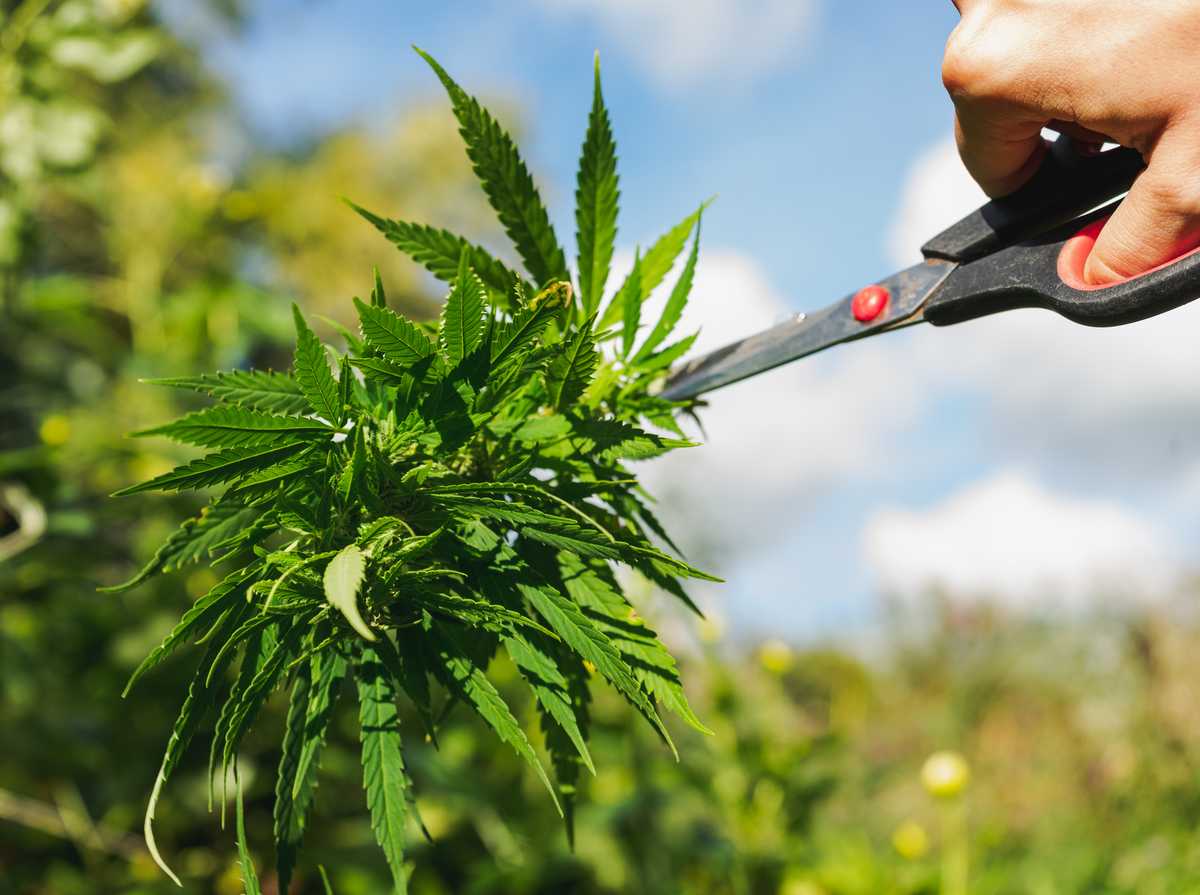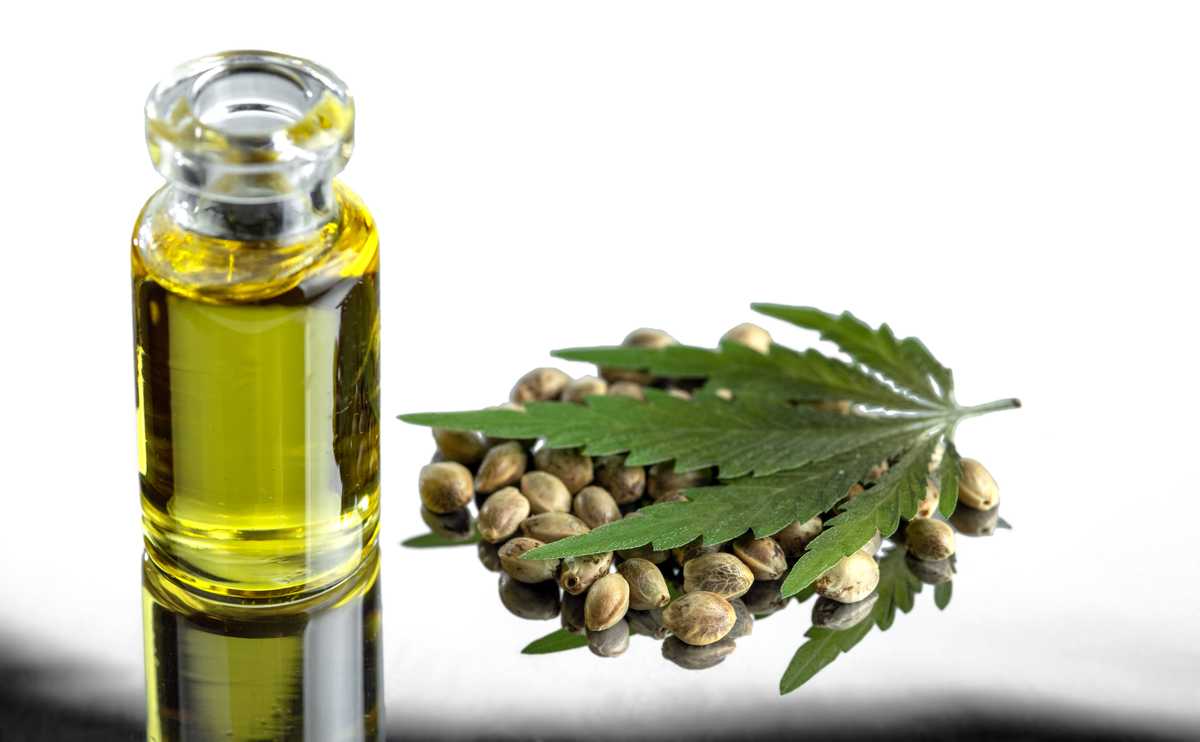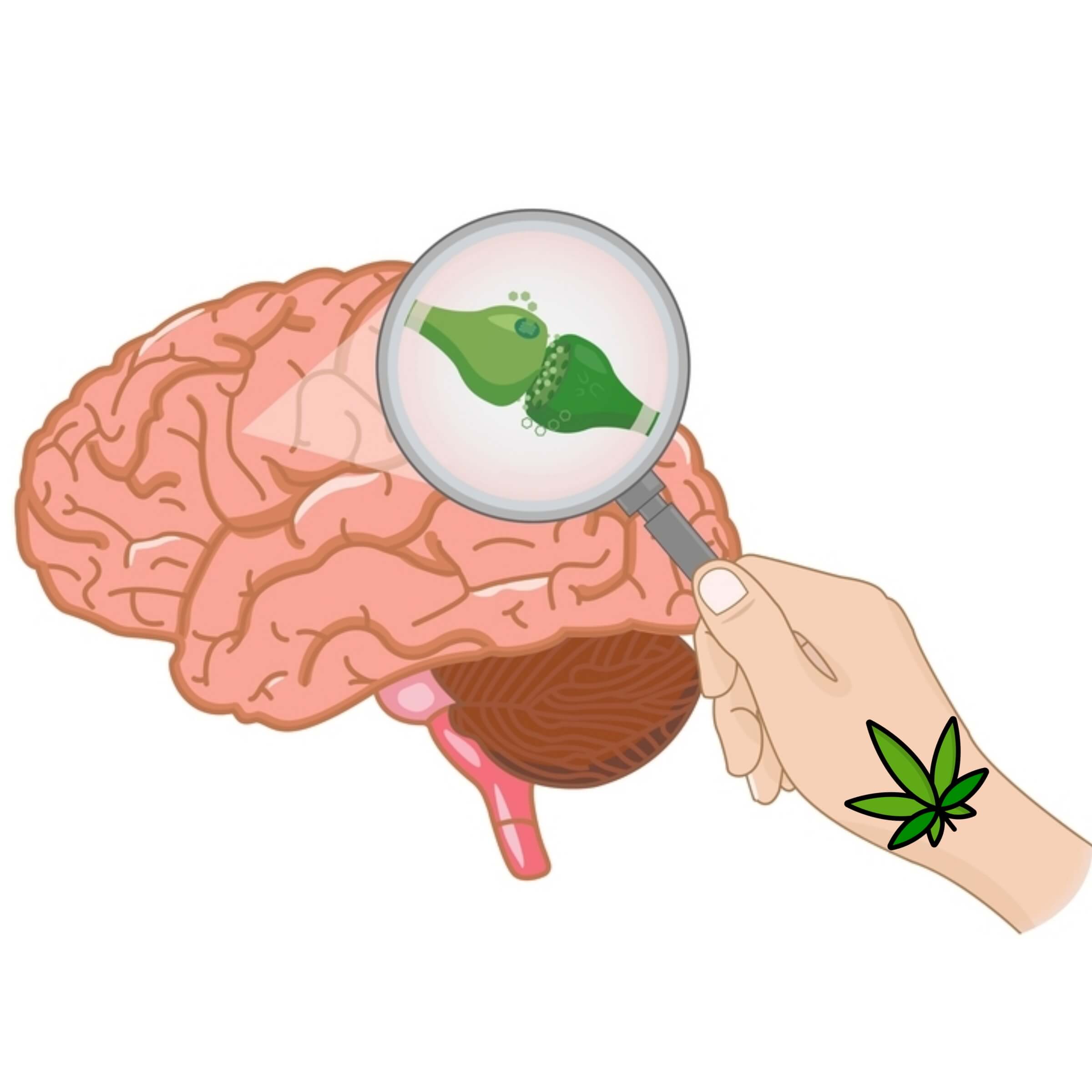
Effects of Cannabis: How It Affects Your Mind & Body
Learn about the effects of cannabis on your body as we look deeper into the new medicinal marijuana revolution in Australia. How is cannabis used to treat illnesses and medical problems?
Note: The information given on this page is not medical advice and should be taken in conjunction with medical professional advice. Individuals wanting medical advice on this issue should consult their local healthcare professionals.
The Endocannabinoid System & The Effects Of Cannabis
Cannabis acts through The Endocannabinoid System (ECS), a neural signalling pathway that was first discovered in the 1990. The ECS is believed to be involved with returning the body to a balanced state as well as, processes, such as fertility, appetite, mood, pain, and memory formation. Our body makes cannabinoids naturally, called endocannabinoid and these are what naturally interact with the ECS. Anandamide is an endocannabinoid and is involved in the feeling of the “runners high” experienced after exercise.
The 3 types of Cannabinoid
-
Endocannabinoids - Produced naturally in the body by animals and humans as a neural system dedicated to homeostasis.
-
Phytocannabinoids - Produced naturally in cannabis plants and other plants species around the world.
-
Synthetic cannabinoids - Not produced naturally and lacks the sum of its parts (pure THC or CBD)
What are Phytocannabinoids?
Phytocannabinoids are the chemical compounds often found in the cannabis flower that has been shown to proceed relief to an array of medical symptoms. For example, THC & CBD are Phytocannabinoids, that have effects on pain, nausea, anxiety and inflammation. When there is a deficiency or problem with our endocannabinoid system, cannabinoids from the cannabis plant can be used as supplements to restore balance.
Common Cannabinoids Found In Cannabis
- Cannabigerols (CBG)
- Cannabichromenes (CBC)
- Cannabidiols (CBD)
- Tetrahydrocannabinols (THC)
- Cannabinol (CBN)
- Cannabinodiol (CBDL)
- Cannabicyclol (CBL)
- Cannabielsoin (CBE)
- Cannabitrio (CBT)
- Cannabivarin (CBV)
- Tetrahydrocannabivarin (THCV)
- Cannabidivarin (CBDV)
- Cannabichromevarin (CBCV)
- Cannabigerovarin (CBGV)
- Cannabigerol Monoethyl Ether (CBGM)
Why Does Cannabis Work On The Human Body?
THC’s chemical structure is similar to the brain chemical anandamide. Similarity in structure allows chemicals to be recognized by the body and alter normal brain communication.
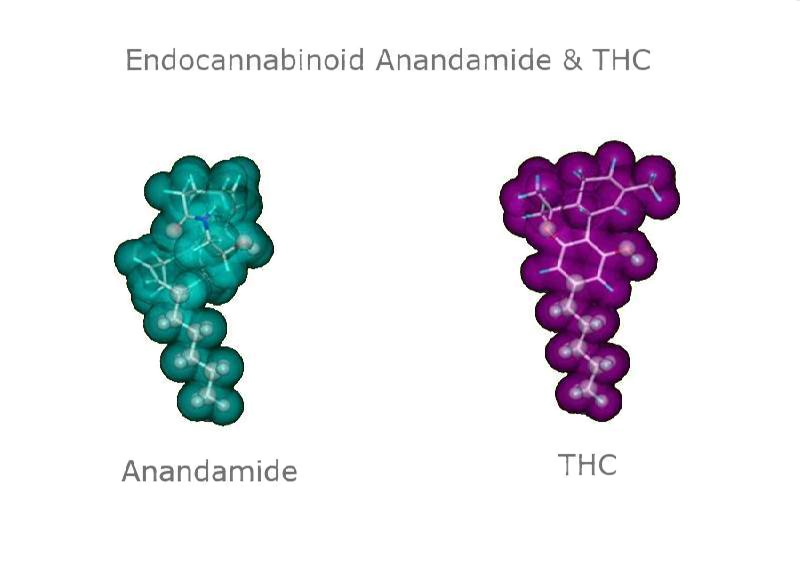
How Do Cannabinoids Work?
Cannabinoids such as THC and CBD binding to the existing ECS receptors in the body, much like a lock and key. The two most popular Cannabinoid receptors found in the body are the CB1 & CB2 receptor. The majority of CB1 & CB2 receptors are found in our brain and immune system. THC & CBD have similar biochemical structures to other naturally occurring endocannabinoids, making them able to mimic or disrupt the bodies endocannabinoid system.
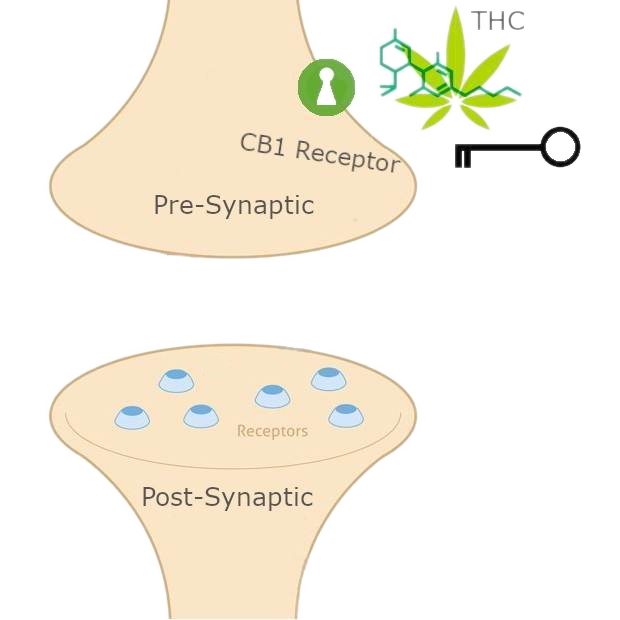
Therefore, once cannabis enters the body, the assortment of cannabinoids binding with many of the endocannabinoid receptors throughout the body. One well-known effect is when THC binds and stimulates the CB1 receptors, this results in the iconic intoxicated or “high” feeling, whereas CBD can counteract this effect and “sober” the effects of THC on a person.
What are Terpenes?
Terpenes are a large group of aromatic oils that are found in the cannabis plant and many other plants species. Two examples are the terpenes that give lemons their citrus smell (limonene) and pine needles their iconic smell (Pinene). There are more than 20,000 different terpenes that occur in nature and the cannabis plant contains more than 100 of these terpenes.
Like cannabinoids, terpenes bind to receptor sites in the brain and give rise to various effects, these effects are dependent on the type of terpene, the concentration of both the terpene and cannabinoids in the bloodstream and the individual’s genetic makeup.
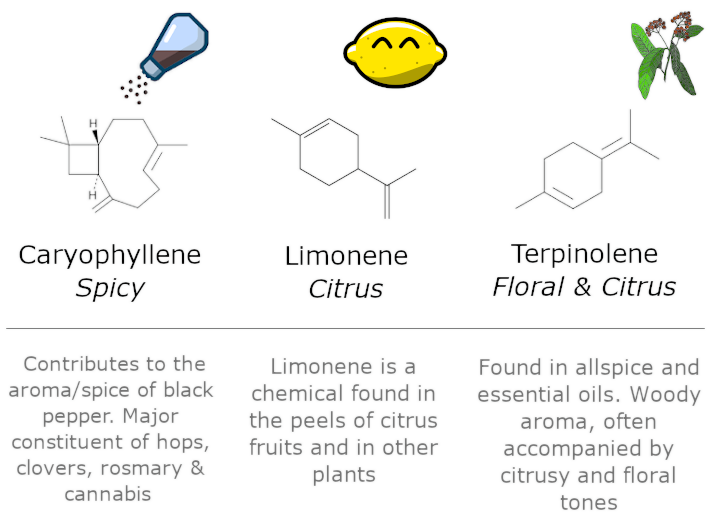
What Do Terpenes do?
Without the concoction of terpenes, THC and CBDs effects are lessened from a medical perspective, as the entourage effect of terpenes and cannabinoids plays an important role in the cause and effect of the cannabis plant. People often attribute the lack of terpenes and other cannabinoids to why pure synthetic THC is less effective.
Therefore, Terpenes “aid” cannabinoids in their medical application on the human body (Read More). one analogy is if we think of THC as the engine in a car and the terpene as the steering wheel that drives that car towards its effect. Understanding this we can now talk about, how cannabis species Indica and Sativa only differ in their Terpenes, not their THC and CBD molecules, explaining the differing effects between plants.
-
Myrene - A terpene found mainly in Indica cannabis strains and also the mango fruit. In combination with THC, Myrene produces sedative effects and the iconic “couch high” associated with Indica strains.
-
Limonene - A terpene found mainly in Sativa species plants produces the energetic, “up-lifting high” effect, iconic in many Sativa strains.
“We have barely begun to understand the therapeutic potential of cannabis,” says Ethan Russo, a neurologist and director of R&D at the International Cannabis and Cannabinoids Institute, in the Czech Republic.
“We haven’t taken the steps that are required to really harness the abilities of some of these minor cannabinoids, particularly in conjunction with optimized terpenoid profiles.”
Where On The Plant Are Cannabinoids, Terpenes & Trichromes Found?
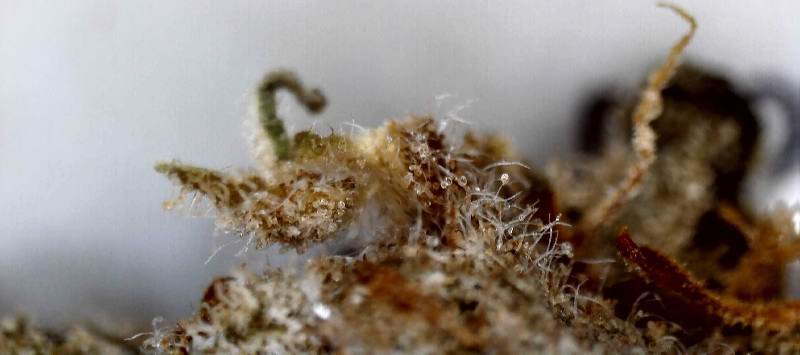
The Cannabis’ plant has crystal-like hairs all over the surface of the plant, which are largely concentrated around the female flowers, sugar leaves and house of the seeds. These crystal-like structures are called trichomes, and they excrete a sticky resin giving cannabis its distinct smell. The smell from the plant is attributed to the accumulation of terpenes in the droplets at the tip of each hair. Not only do terpenes get created in the Trichomes, so do the majority of THC & CBD in the plant. For example, Every part of the cannabis plant contains little amounts of THC depending on the Trichrome concentration in the area:
- Leaves and stems have around 4% THC content
- Flowers have up to 25 - 30% THC content
Why Does The Plant Have Trichromes?
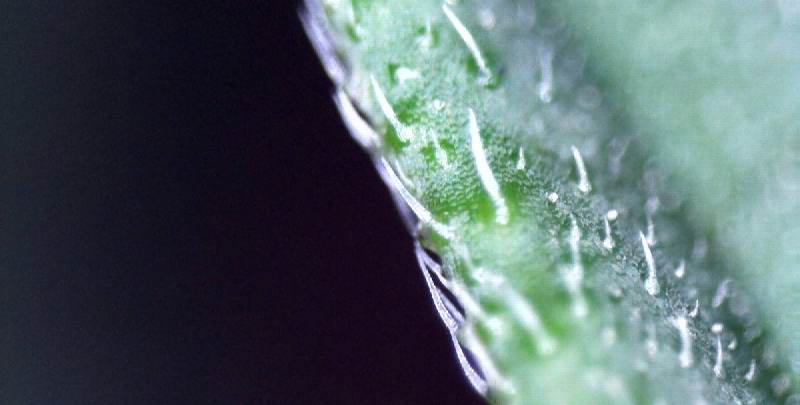
Trichomes are a defence mechanism evolved to prevent herbivores from consuming the cannabis plant, with its pungent smell, sappy texture and bitter taste when in full flower. Cannabis plants have developed this mechanism as a last-ditch effort to procreate, as when a cannabis plant flowers it uses all its energy to try and produce seeds before death.
Pollinators such as bees, flies and other insects are attracted to the smell, resulting in these insect leaving pollen on the sticky, sappy flower. Unlike most plants, cannabis has distinct genders, resulting in either male or female plants. The Female plant produces the flowers which contain large amounts of both THC & CBD in its Trichomes, whereas the male plant focus on pollen production to fertilise the flower.
Pollination of a female plant reduces the effectiveness of the plant, as once the female plant has been fertilised the plant puts all its energy into seeds rather than cannabinoids and terpenes. Therefore, when growing for medical purposes, the female’s plants are kept isolated away from potential pollen sources, this ensures the most potent medicine is harvest.
What are the Cannabis Species?
The three subspecies of the cannabis are:
- Cannabis Sativa
- Cannabis Indica
-
Cannabis Ruderalis
- Sativa - Energy, Stimulation, Head High & Focus
- Indica - Couch-Locked, Body High, Deep Relaxation & Appetite Stimulation
- Ruderalis - High-CBD & Low ThC Species Of Cannabis.
What Are Cannabis Strains?
It’s important to select the right strain depending on the medical treatment or application. For example, THC-dominant strains are used in the treatment of pain, depression and increase appetite. CBD-dominant strains, on the other hand, are used to treat symptoms of anxiety, muscle spasticity, migraines and PTSD.
There are many genetic combinations possible for each plant. Genetic factors can change cannabinoid ratios, terpenes profile and other traits such as autoflower capabilities. Growers selectively bred for desired traits that are unique to their plants. One such example is:
The ACDC Strain:
- CBD-dominant strain
- Sativa-dominant strain.
- < 1% THC & 11 - 15% CBD.
- little-to-no intoxicating effects due to high CBD:THC ratio.
- Most common terpenes = Myrcene, Pinene & Caryophyllene.
ACDC is often used to treat Crohn’s Disease, Irritable Bowel Syndrome & Ulcerative Colitis. THC activation of both CB1 & CB2 receptors in the gut reduces spasticity of the gastrointestinal tract and inhibits immune system secretions that cause inflammation in the bowls.
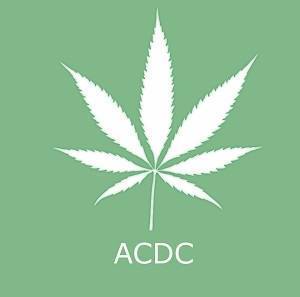
Additionally CBD also reduces inflammation and lead to symptom relief in IBS, along with anti-bacterial properties. In the case of these chronic bowel disease, both CBD & THC have a synergistic effect, resulting in better health outcomes than if used alone. As mentioned before the power of cannabis is in its entourage effect, and the almost infinite possible cannabinoid and terpene combination.
What Makes A Strain CBD or THC?
CBD is the second-most frequent used cannabinoid in cannabis, a cannabinoid that was almost genetically lost due to the legality of cannabis and the underground drug communities desire for high THC strains. Many strains differ in their CBD and THC ratios, below are “rules of thumb” for what determines High vs Low THC & CBD:
- High THC, low CBD (10-30% THC, trace amounts of CBD)
- Hybrid CBD/THC (5-15% THC and CBD)
- High CBD, low THC (5-20% CBD, THC under 5%)

Note The cannabinoid ratio is always read THC to CBD – In the picture above 10:10, For every 1ml there is 10mg THC and 10mg CBD.
The Side Effects Of Cannabis
Note. Use of any drug always carries some risk. It’s important to be careful when taking any type of drug.
Cannabis can affect every individual differently depending on genetics, strain type and environmental factors. Even the same person may have a different experience on separate occasions or over the course of their life.
From an environmental perspective, this is due to the phenome known as “context-dependent memory”, in which events that have occurred following the consumption of alcohol or other drugs on a frequent basis are subconsciously learnt by the body.
The human body likes to return to its normal stable state (homeostasis). Environmental cues such as being in the same room or pre-drug rituals can lead to tolerance. The human body proactively counters the effects of the drug, even before consumed due to environmental cues. While tolerance can occur due to this phenomenon, so can hyper-sensitivity.
In the cases of opium-based substance, an individual lacking their normal environmental cues will not give their body a chance to proactively counter the drug effect. Therefore, someone who takes the same dose every day, however in a new environment, runs the risk of overdosing in this novel setting. Researchers believe this is why most heroin overdose cases occur in unfamiliar environments
Some factors that influence the effects of cannabis on the human body:
- BMI - Height & Weight.
- Gender - Both biological and psychosocial differences.
- Personal Tolerance - Neuroplastic changes in receptor density and signalling pathways.
- Genetic Factors - How quick they metabolise the drug.
- The Dose/Strength - How potent the THC/CBD levels are between strains.
- Environmental/cognitive expectations of consuming cannabis.
Cannabis Effects On Food Intake
One common effect of THC is the increasing drive for food consumption when the CB 1 receptor is activated in the Nucleus Accumbens causing the release of dopamine in the presynaptic neuron. The Nucleus Accumbens is associated with both rewarding and reinforcing behaviours such as eating, drinking, sex and exercise.
While THC may increase food intake, CBD has no such effect on appetite, rather studies have shown chronic use leads to weight loss Read More.
Cognitive Effects of Cannabis
- Attention/Concentration
- Decision Making & Risk Taking
- Memory
- Control/Inhibition
- Psychomotor function
Attention/Concentration: To date, there is little evidence of the impairing effects of cannabis on attention. However, some evidence suggests that less experienced cannabis users, who haven’t established tolerance towards cannabis, can have both their attention and concentration disrupted. light users can encounter impairment when about 0 - 6 hours have passed since their last use of cannabis. Conversely, in heavy users, the impairing attention effect only occurs when an individual abstaining from cannabis use for a period of time. Following chronic cannabis use, deficits remain till the next acute intoxication or after a couple of weeks abstaining. Read More.
Decision Making & Risk Taking: Research has shown cannabis users can be significantly impaired when decision-making and risk-taking. Studies have compared the withdrawal effects of cannabis, showing that after 25 days of use, if an individual decides to be abstinent, they are more likely than control groups to be suboptimal the Iowa gambling task (IGT); IGT is a psychological task thought to simulate real-life decision making Read More. Other studies also suggest cannabis effect on decision making and risk-taking is comparable with that of cocaine Read More.
When comparing cannabis groups to placebo groups, aspects of planning and decision are disrupted leading to:
- Increases in the total time an individual takes to make a response on a task.
- Decreased Accuracy to make the correct choice when compared to the non-cannabis group.
Inhibition and Impulsivity: So far research has shown that acute intoxication with a high dose of THC resulted in significant impairment on a measure of impulsivity Read more. Cannabis consumption makes impulsive behaviour more likely and has been shown to lead to less inhibition of negative behaviours/thoughts. However, recovery from these deficits generally returns to a normal level after a month or more of abstinence.
Heavy cannabis users demonstrated significantly more errors of inhibition compared with light users Read more. The severity of these deficits are correlated with the amount of THC use.
Memory: The hippocampus is a region in the brain related to memory formation. The hippocampus contains a large quantity of CB1 receptors resulting in the impaired short-term memory effects of THC and the “fleeting memory” iconic of cannabis use. Additionally, the impairments induced by a single dose of THC on verbal and working memory is similar to that of alcohol. The same can not be stated for strains high in CBD, as its only the dose of Δ9-THC, that greatly impairs memory Read More.
Cannabis withdrawal symptoms
In heavy cannabis users, withdrawal symptoms (e.g., irritability, aggression, anxiety, restlessness & sleep disturbances.) have been shown to be at their worst between Days 2 and 6 after cessing consumption Read More. These Cannabis-related side effects can last anywhere from 4 to 14 days and are a result of building up a tolerance to the cannabinoids.
Acute Cannabis Effects
The Subjective experiences of cannabis are euphoria, sedation, perceptual disorientation, laughter and intensification of sensory experiences (sound, taste, etc) Read More.
From a physical point of view:
- Increase appetite/food intake.
- Dry Mouth
- Heart rate increase by 20 - 50% (~3 hours)
- Blood pressure increase
- Conjunctival Hyperemia (Bloodshot eyes)
Short-Term Effects Of Cannabis (0 to 6 hours after use)
Smoking cannabis produces levels of THC in blood plasma that can be detected almost immediately and which reach peak concentrations within minutes. The psychoactive effects of cannabis are experienced immediately after smoking, with peak levels of intoxication occurring after approximately 30 minutes and lasting several hours Read More.
Long-Term Effects Of Cannabis (3 weeks or longer)
The long-term impairment effects of cannabis usually manifest as withdrawal-like symptoms. Following abstinence after chronic cannabis use. In addition, the age of onset of cannabis use is another factor that determines the long-term effects of cannabis. One well‐known function of the endocannabinoid system in regulating brain development, therefore, it’s not surprising that the onset of cannabis use during critical periods of development can influence brain structure and function.
common withdrawal symptoms:
- Irritability
- Difficulty sleeping
- Decreased appetite
- Restlessness
- Nausea
- Abdominal pain
Disclaimer: Cannabis Place are not doctors and we recommend consulting health professionals for accurate information. This site may contain information regarding drugs. This medicinal cannabis content is designed for an 18+ audience. Click here for our full disclaimer
